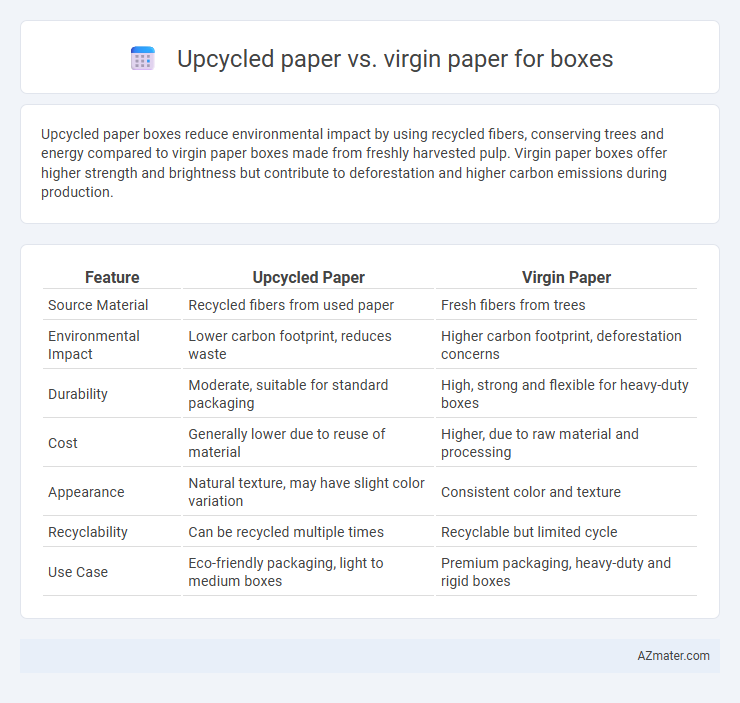Upcycled paper boxes reduce environmental impact by using recycled fibers, conserving trees and energy compared to virgin paper boxes made from freshly harvested pulp. Virgin paper boxes offer higher strength and brightness but contribute to deforestation and higher carbon emissions during production.
Table of Comparison
| Feature | Upcycled Paper | Virgin Paper |
|---|---|---|
| Source Material | Recycled fibers from used paper | Fresh fibers from trees |
| Environmental Impact | Lower carbon footprint, reduces waste | Higher carbon footprint, deforestation concerns |
| Durability | Moderate, suitable for standard packaging | High, strong and flexible for heavy-duty boxes |
| Cost | Generally lower due to reuse of material | Higher, due to raw material and processing |
| Appearance | Natural texture, may have slight color variation | Consistent color and texture |
| Recyclability | Can be recycled multiple times | Recyclable but limited cycle |
| Use Case | Eco-friendly packaging, light to medium boxes | Premium packaging, heavy-duty and rigid boxes |
Introduction to Upcycled Paper and Virgin Paper
Upcycled paper for boxes is crafted from recycled fibers, minimizing waste and reducing environmental impact compared to virgin paper, which is produced from freshly harvested wood pulp. Virgin paper offers superior strength and uniformity, making it ideal for packaging requiring durability and high-quality print finishes. The choice between upcycled and virgin paper depends on balancing sustainability goals with performance and appearance requirements in box manufacturing.
Environmental Impact of Upcycled Paper Boxes
Upcycled paper boxes significantly reduce environmental impact by minimizing waste and lowering energy consumption compared to virgin paper production. These boxes decrease the demand for deforestation, conserve natural resources, and reduce greenhouse gas emissions. Their sustainable lifecycle supports eco-friendly packaging solutions and promotes circular economy practices in the box manufacturing industry.
Virgin Paper Box Production: Resource Consumption
Virgin paper box production demands significant natural resources, notably large volumes of water and energy, with estimates showing it consumes up to 50% more water compared to recycled paper manufacturing. The process typically involves cutting down mature trees, contributing to deforestation and habitat loss, while chemical treatments release pollutants into air and water systems. Despite producing strong and durable boxes, this high resource consumption results in a considerable environmental footprint compared to upcycled paper alternatives.
Energy and Water Usage Comparison
Upcycled paper for boxes consumes approximately 60-70% less energy compared to virgin paper production, significantly reducing carbon emissions. Water usage in upcycled paper manufacturing is also substantially lower, often using 30-50% less water due to the reuse of materials and reduced pulping processes. These efficiency gains make upcycled paper a more sustainable choice for box production with notable environmental benefits.
Carbon Footprint: Upcycled vs Virgin Paper
Upcycled paper boxes significantly reduce carbon footprint by reusing existing paper fibers, lowering emissions from raw material extraction and processing compared to virgin paper. Virgin paper production involves intense forestry activities and energy consumption, resulting in higher greenhouse gas emissions. Choosing upcycled paper for boxes contributes to sustainable packaging by minimizing deforestation and conserving natural resources.
Quality and Performance of Upcycled Paper Boxes
Upcycled paper boxes demonstrate competitive quality and performance compared to virgin paper alternatives, offering strong durability, excellent printability, and resistance to tearing. The recycling process used in upcycled paper maintains fiber strength, ensuring rigidity and protection suitable for packaging applications. Advances in sustainable manufacturing have enhanced the consistency and aesthetics of upcycled paper boxes, making them a reliable choice for eco-friendly packaging without compromising functionality.
Cost Analysis: Upcycled Paper vs Virgin Paper
Upcycled paper for boxes typically reduces raw material costs by reusing waste paper, leading to lower production expenses compared to virgin paper, which requires more energy and resource-intensive pulping from fresh wood fibers. Virgin paper's higher durability and quality often command premium pricing, but upcycled paper offers competitive pricing due to decreased environmental impact and raw material acquisition costs. Cost analysis reveals that upcycled paper minimizes waste management costs and lowers carbon footprint-related expenses, presenting significant economic and sustainability advantages over virgin paper in box manufacturing.
Packaging Aesthetics and Customization Options
Upcycled paper for boxes offers a unique, textured aesthetic that appeals to eco-conscious consumers, featuring natural fiber patterns and subtle color variations that enhance brand storytelling. Virgin paper enables precise, vibrant printing and smooth surfaces ideal for intricate designs, high-resolution logos, and premium finishes, elevating the overall packaging appearance. Customization options on virgin paper include embossing, debossing, foil stamping, and spot UV coating, while upcycled paper customization tends to emphasize natural, rustic looks compatible with organic branding.
Consumer Perceptions and Market Trends
Consumers increasingly prefer upcycled paper for boxes due to its eco-friendly appeal and lower environmental impact compared to virgin paper. Market trends indicate a growing demand for sustainable packaging, driven by heightened awareness of plastic waste and deforestation issues. Brands leveraging upcycled paper benefit from enhanced brand reputation and appeal to environmentally conscious buyers seeking responsible consumption choices.
Which Box Is Better? Sustainability Considerations
Upcycled paper boxes outperform virgin paper boxes in sustainability by reducing the demand for fresh timber, lowering water usage, and minimizing greenhouse gas emissions during production. Virgin paper boxes, derived directly from new wood pulp, contribute to deforestation and higher environmental impacts despite offering pristine material quality. Choosing upcycled paper boxes supports circular economy principles and significantly decreases the ecological footprint of packaging solutions.

Infographic: Upcycled paper vs Virgin paper for Box
 azmater.com
azmater.com